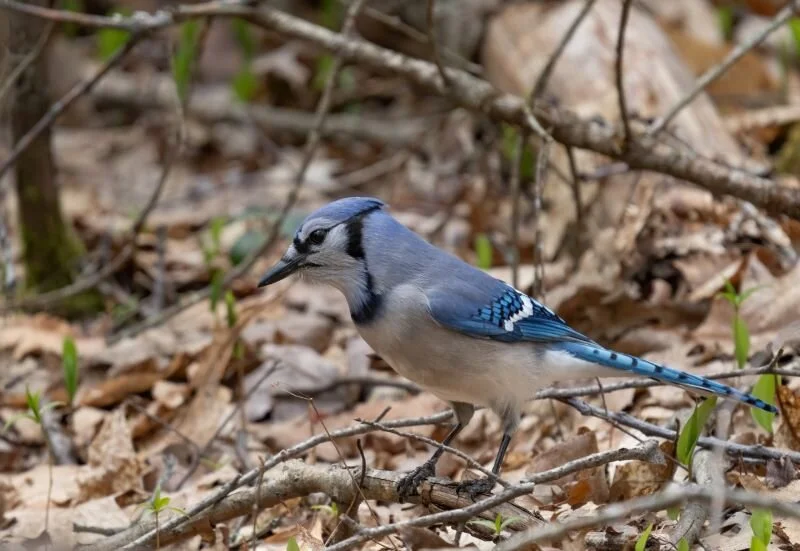“One Blue Jay can cache up to 5,000 acorns in a single autumn season.”
It's another big acorn year, and many oak trees have dropped their acorns relatively early - presumably because they are stressed from the drought, and can’t afford the resources needed to grow their seeds to maturity.
Like many fruit and nut-producing trees, oaks have collectively large crop years (usually about every two to three years), and other years where production is low. It’s rare to have two boom years in a row, however (such as we’ve had in 2019 and 2020).
These boom and bust cycles are known as “masting”, an adaptive and synchronous behavior that is coordinated among trees in order to improve their collective chances of reproduction. Masting is just one example in a growing body of science that demonstrates how trees can communicate to one another, and across vast distances!
The nuts of our mighty oaks fall heavy and hard when the wind blows, making you jump and think to yourself - "maybe I should be wearing a hard hat out here?!" Meanwhile, small flocks of blue jays (often family groups) are moving through hardwood forests - busily collecting and caching these synchronized seeds.
These highly social and intelligent birds can carry five acorns at a time (2 - 3 in a pouch in their throat, one in their mouth, and one more in the tip of the bill). One Blue Jay can cache up to 5,000 acorns in one season. They will eat the acorns that are infested with protein-rich weevils right away, and cache the rest for leaner times.
Like other birds that store food, jays have advanced spatial memory skills and an enlarged hippocampus - the brain's built-in GPS. However, they have several thousand acorns to keep track of and will forget where some of them are. These will become tomorrow's mighty oaks!
I hope you enjoyed this Phenology Note!
Join me in witnessing the seasons of our wild world.
Posted regularly here, and on Facebook and Instagram:
Follow #ThePersonalEcologist & #PhenologyNotes
SIGN UP TO RECEIVE EVENT NOTICES & FREE HABITAT TIPS, TOOLS, AND TRICKS.
#ThePersonalEcologist
I co-create biodiverse habitats with eco-minded stewards throughout the Northeast - at any scale.
I have 30 years of experience and a lifelong commitment to wildlife conservation.
Read My Story.
-
Deborah
Perkins
- Jan 17, 2026 The True Harbingers of Spring: Chickadees
- Jan 8, 2026 Carnivore Coexistence (Leopold's Wise Words - Part 1)
- Oct 31, 2025 Hallowed Habitat
- Dec 22, 2023 Storm Habitat: Nurse Logs, Dens, and More
- Aug 8, 2023 Beautiful Buttonbush in Bloom
- Jun 17, 2023 Snapping Turtles on the Move
- Mar 20, 2021 The Power of Photoperiod
- Feb 19, 2021 The Golden-crowned Kinglet: A Royally Charming Winter Resident
- Feb 8, 2021 Subnivean Secrets
- Jan 9, 2021 Wild Reads: Ravens in Winter
- Oct 23, 2020 Flower “Beds” for Bumble Bees
- Oct 4, 2020 Wise Oaks, Clever Jays
- Sep 11, 2020 Goldenrods: Top Plants for Boosting Biodiversity
- Aug 25, 2020 Gentle Golden Wasps Adorned with Pollen
- Aug 1, 2020 Water for Wildlife - Birdbath Basics & More
- Jul 19, 2020 Fruits of the Forest
- Jul 11, 2020 Hungry Little Hummingbirds
- Jun 24, 2020 Hatching Out: Mother Nature's "Escape Room"
- Jun 12, 2020 Maine's Real Lupine Revealed
- May 31, 2020 Wild Geranium in Flower
- May 24, 2020 Moosewood Chandeliers
- May 17, 2020 Shadbush in Bloom
- May 7, 2020 Native Nectar for Queen Bumble Bees
- Apr 25, 2020 Waves of Warblers
- Apr 19, 2020 Attracting Bluebirds without Boxes
- Apr 12, 2020 Hungry Bears on the Move
- Apr 5, 2020 Bees on Red Maple Flowers
- Mar 27, 2020 Sky Dancing
- Mar 22, 2020 Fox Kits Being Born
- Mar 15, 2020 Corvids a-Courtin’
- Mar 8, 2020 Phenology Notes: Witnessing The Seasons of our Wild World
- Feb 5, 2019 Plan Your Habitat Garden
- Jan 2, 2019 Wild Reads: We Took to The Woods
- Nov 28, 2018 Winterberry: The Gift that Keeps on Giving
- Aug 16, 2018 Where Have All the Whip-poor-wills Gone?
- Jun 22, 2018 Give a Warm Welcome to Wild Bees (Super-pollinators Part 2)
- May 16, 2018 The Wonder of Wild Bees (Super-pollinators Part 1)
- Apr 19, 2018 Saving Songbirds Starts with Your Morning Coffee
- Mar 21, 2018 Wildlife Habitat Design in A Wounded World
- Feb 16, 2018 “Intelligent Tinkering” - How to Boost Biodiversity at Home (Leopold’s Wise Words Part 2)
- Dec 14, 2017 Dead and Dying Trees are Key to Life
- Nov 14, 2017 A Top Threat to Biodiversity: Invasive Plants
- Sep 21, 2017 Beechnuts - Superfood for Bears & Other Wildlife
- Aug 22, 2017 Baby Bats Need Love Too
- Jul 25, 2017 Bring the Magic of Fireflies Back Home Again






